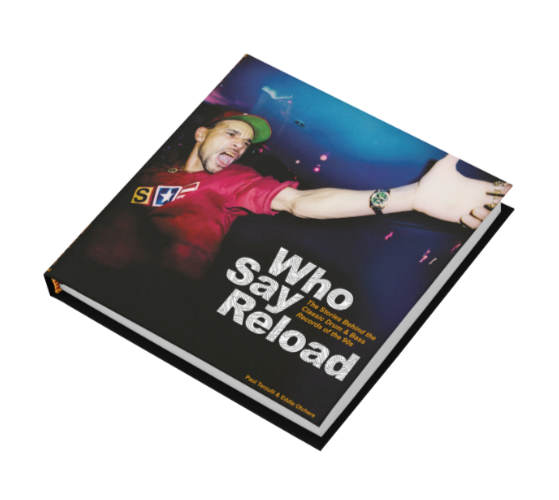Our first book of 2021, Who Say Reload: The Stories Behind the Classic Drum & Bass Records of the 90s, is an oral history of the records that defined jungle/drum & bass straight from the original sources. Photography is provided by Eddie Otchere who has an extensive archive of images, having been the photographer at Goldie’s seminal Metalheadz nights. The book will be 25cm square, and the 174 pages will be printed and bound on heavyweight 130gsm paper with a hardback cover. Here author Paul Terzulli explains how the idea for the book came about.
Part of the appeal of jungle/drum & bass for me was the variety of different styles, sounds and influences you would often find in a single DJ set. Being almost exclusively sample-based to begin with, producers incorporated reggae, hip hop, soul, jazz, rare groove, electro, prog rock, house and techno into their tunes, which always kept things lively. The feeling of not knowing what was coming next was shored up by the fact that there wasn’t a set format for this music.
You could never be entirely sure what would happen once the DJ mixed a record in. A Cutty Ranks or Buju Banton vocal, a techy riff off an R&S Records b-side, or some lush chords and film dialogue. Or just a monstrous breakbeat, chopped up and reconfigured beyond recognition. Listening back to the records from that era now, so much of it still sounds fresh and unique. That’s partially down to nostalgia, but also the fact that there hasn’t really been anything like it since.
The idea for Who Say Reload came about by virtue of no one else having done it. Retrospectives and oral histories for other genres are easy to come by. You’ll have no problem finding books on The Beatles or The Rolling Stones, a documentary on the birth of hip hop in the South Bronx, or stories of Northern Soul all-nighters at the Wigan Casino. Little has been written about jungle though, particularly from the first-person perspective of those who were involved with it at the time.
Part of this was down to the nature of the scene; it has always been very forward-thinking and focused on the music with most of the pioneering artists shying away from publicity or aspirations of mainstream success. It was also down to the media’s attitude towards it, often not taking it seriously or shunning it completely. At best, the story was often simplified as follows: General Levy got in the charts with Incredible, Goldie and Roni Size are amazing and won awards, and then it all went dark and died out, so everyone listened to UK Garage instead. Of course, if you were immersed in the scene and buying records, tape packs, going to raves and checking pirate radio you knew differently, but information on the music and the artists behind it was scarce in the pre-internet age.
Being a huge hip hop fan, I decided to create a drum & bass equivalent of Brian Coleman’s Check The Technique books, which document the making of classic hip hop albums, but instead, I would focus on the big jungle 12” singles. I decided I wanted to cover as broad a spectrum of artists, record labels and styles as possible, with a different chapter for each track. Initially, I planned to focus solely on the golden era of anthems that emerged between 1993 and 1996. I then took on board the suggestion to precede this with some of the records that formed the sound’s blueprint during the breakbeat hardcore era of 1990 – 1992.
Once that was in place, it seemed only right to cover the whole decade and add some of the bigger tunes that were emblematic of how the genre had progressed as the millennium approached. The story begins with Shut Up And Dance and 4Hero, takes in DJ Hype, Krome & Time and J Majik, and ends with Optical and Bad Company. In amongst this, I included interviews with some well-known DJs such as Flight, Friction and Fabio to provide additional commentary on the records, producers and raves that stood out to them during the 90s.
Having made some progress with the content of the book, I realised I would need some images to accompany the text. Searching online for relevant photos, I noticed Eddie Otchere’s name kept appearing in the credits. I contacted him through Twitter, and after a brief chat, we arranged to meet. This was the point that the project really began to take shape. Ed had a substantial archive of photos of DJs, producers, clubs and ravers taken from 1994 onwards and had been thinking about a suitable platform for showcasing them. He understood what I wanted to, and we shared ideas on how we could put it all together. I’m really pleased with the final result and hope it goes some way to filling in the gaps in the drum & bass story.
To accompany the sale of the book we have a fantastic Who Say Reload A2 poster on offer, with label images of 36 of the records included, in chronological order. These are limited to 200 copies and won’t be available forever, so make sure you get in there quickly!


